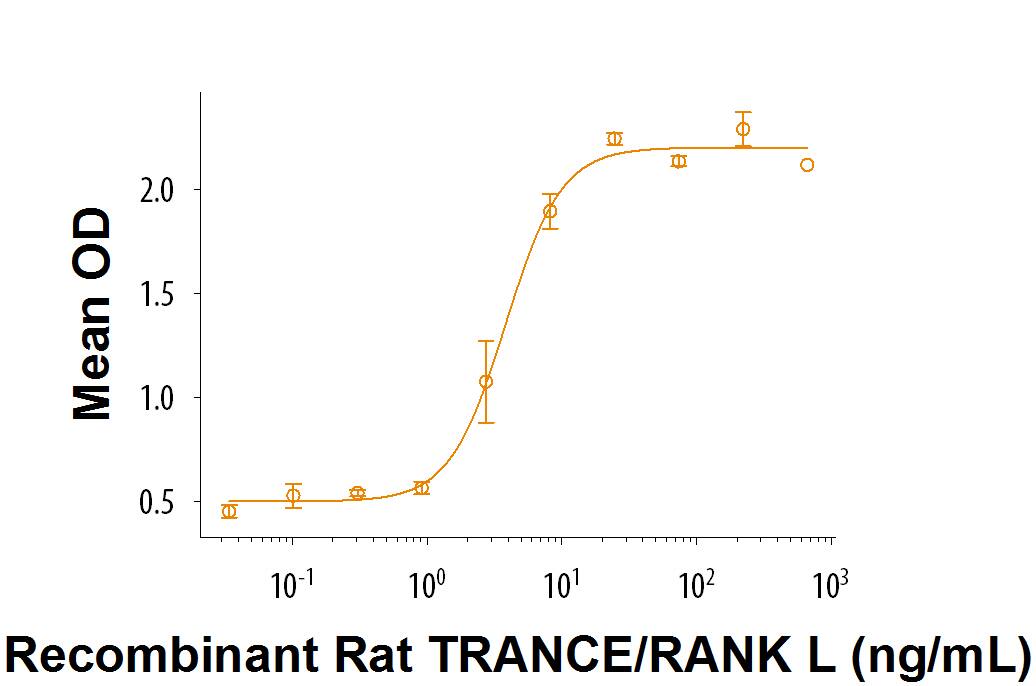Recombinant Rat TRANCE/RANK L/TNFSF11 Protein
R&D Systems, part of Bio-Techne | Catalog # 9366-TN

Key Product Details
Product Specifications
Source
Arg72-Asp318, with an N-terminal 6-His tag
Purity
Endotoxin Level
N-terminal Sequence Analysis
Predicted Molecular Mass
SDS-PAGE
Activity
The ED50 for this effect is 2.5-15 ng/mL in the presence of 2.5 µg/mL of a cross-linking antibody, Mouse Anti-polyHistidine Monoclonal Antibody (Catalog # MAB050R).
Scientific Data Images for Recombinant Rat TRANCE/RANK L/TNFSF11 Protein
Recombinant Rat TRANCE/RANK L/TNFSF11 Protein Bioactivity
Recombinant Rat Trance/RANK L/ TNFSF11 (Catalog # 9366-TN) Induces Osteoclast Differentiation of the RAW 264.7 Mouse Monocyte/Macrophage Cell Line. The ED50 for this effect is 2.5-15 ng/mL in the presence of 2.5 µg/mL of a cross-linking antibody, Mouse Anti-polyHistidine Monoclonal Antibody (Catalog # MAB050R).Formulation, Preparation and Storage
Carrier Free
What does CF mean?CF stands for Carrier Free (CF). We typically add Bovine Serum Albumin (BSA) as a carrier protein to our recombinant proteins. Adding a carrier protein enhances protein stability, increases shelf-life, and allows the recombinant protein to be stored at a more dilute concentration. The carrier free version does not contain BSA.
What formulation is right for me?In general, we advise purchasing the recombinant protein with BSA for use in cell or tissue culture, or as an ELISA standard. In contrast, the carrier free protein is recommended for applications, in which the presence of BSA could interfere.
Carrier: 9366-TN
| Formulation | Lyophilized from a 0.2 μm filtered solution in NaH2PO4, NaCl and EDTA with BSA as a carrier protein. |
| Reconstitution | Reconstitute at 100 μg/mL in PBS containing at least 0.1% human or bovine serum albumin. |
| Shipping | The product is shipped at ambient temperature. Upon receipt, store it immediately at the temperature recommended below. |
| Stability & Storage | Use a manual defrost freezer and avoid repeated freeze-thaw cycles.
|
Carrier Free: 9366-TN/CF
| Formulation | Lyophilized from a 0.2 μm filtered solution in NaH2PO4, NaCl and EDTA. |
| Reconstitution | Reconstitute at 100 μg/mL in PBS. |
| Shipping | The product is shipped at ambient temperature. Upon receipt, store it immediately at the temperature recommended below. |
| Stability & Storage | Use a manual defrost freezer and avoid repeated freeze-thaw cycles.
|
Background: TRANCE/TNFSF11/RANK L
References
- Leibbrandt, A. and J.M. Penninger 2008) Ann. N. Y. Acad. Sci. 1143:123.
- Wong, B.R. et al. (1997) J. Biol. Chem. 272:25190.
- Anderson, D.M. et al. (1997) Nature 390:175.
- Lacey, D.L. et al. (1998) Cell 93:165.
- Hikita, A. et al. (2006) J. Biol. Chem. 281:36846.
- Kong, Y-Y. et al. (1999) Nature 397:315.
- Accession # NP_143026 and EAX08679.
- Sabbota, A.L. et al. (2010) Cancer Res. 70:5558.
- Aoki, S. et al. (2010) J. Bone Miner. Res. 25:1907.
- Fata, J.E. et al. (2000) Cell 103:41.
- Hanada, R. et al. (2009) Nature 462:505.
- Osako, M.K. et al. (2010) Circ. Res. 107:466.
- Schramek, D. et al. (2010) Nature 468:98.
- Gonzalez-Suarez, E. et al. (2010) Nature 468:103.
- Dougall, W.C. and M. Chaisson (2006) Cancer Metastasis Rev. 25:541.
- Sobacchi, C. et al. (2007) Nat. Genet. 39:960.
Long Name
Alternate Names
Gene Symbol
UniProt
Additional TRANCE/TNFSF11/RANK L Products
Product Documents for Recombinant Rat TRANCE/RANK L/TNFSF11 Protein
Product Specific Notices for Recombinant Rat TRANCE/RANK L/TNFSF11 Protein
For research use only
